In electronics, the end goal is to make electronic circuits. A circuit combines electronic components connecting to perform a specific task or function. Without the components, it is not possible to design anything.
Electronic components are devices that perform a specific function, and we use them to make useful circuits. For example, a diode and transistor are electronic components. Each component has its own function and circuit symbol. They come in different shapes and sizes. Some operate at low voltages while some require high voltages and power.
Let’s learn more about basic electronic components in detail.
Basic electronic components
We need breaks to make buildings. Similarly, we need electronic components to make electronic circuits. So, if a beginner wants to understand the basics of electronics, it is compulsory to learn the basics of these components.
1. Definition
In simple words,
Electronic components are devices that are made of semiconductors to perform specific functions when provided with the right conditions (i.e., proper voltage and current)
There are various types of components. Each has its own function and circuit symbol.
2. Difference between electrical & electronic components
When we see a PCB board we see a lot of components there. Remember, not all these components are electronic components.
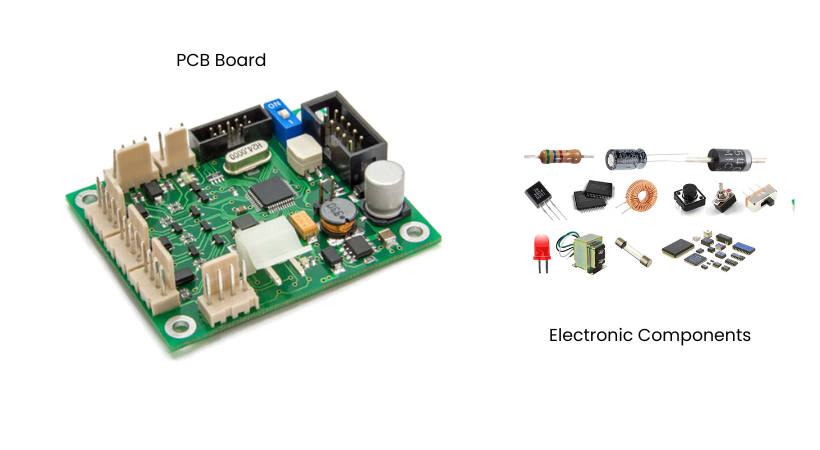
Some of them are electrical components as well.
So how can we tell the difference?
All the components that are made of semiconductor materials i.e., Silicon (Si) or Germanium (Ge) would be considered electronics components.
Those components which don’t pass this definition will be considered electrical components.
Right!
Here is the list of some basic electronic components
- Diodes (PN, Zenor)
- LEDs
- SCR
- Transistors
- MOSFETS
- JFET
- ICs
On the other side, here is the list of some basic electrical components
- Resistor
- Capacitor
- Inductor
- Transformers
- Relays
- Switches
Sometimes people combine these two different types of components and call them electronic components.
I don’t think combining them is a good idea. But they justify it like this electronics is a branch of electrical engineering.
It is up to you how you want to remember them. My suggestion is to keep them in different groups as it is the right way to do so
Electronic components symbols And functions
To build an electronic circuit we have to understand electronic components and their functions.
For circuit schematics (drawing), we use component symbols. Symbols are representative of the respective component.
Following is an example of a circuit schematic.
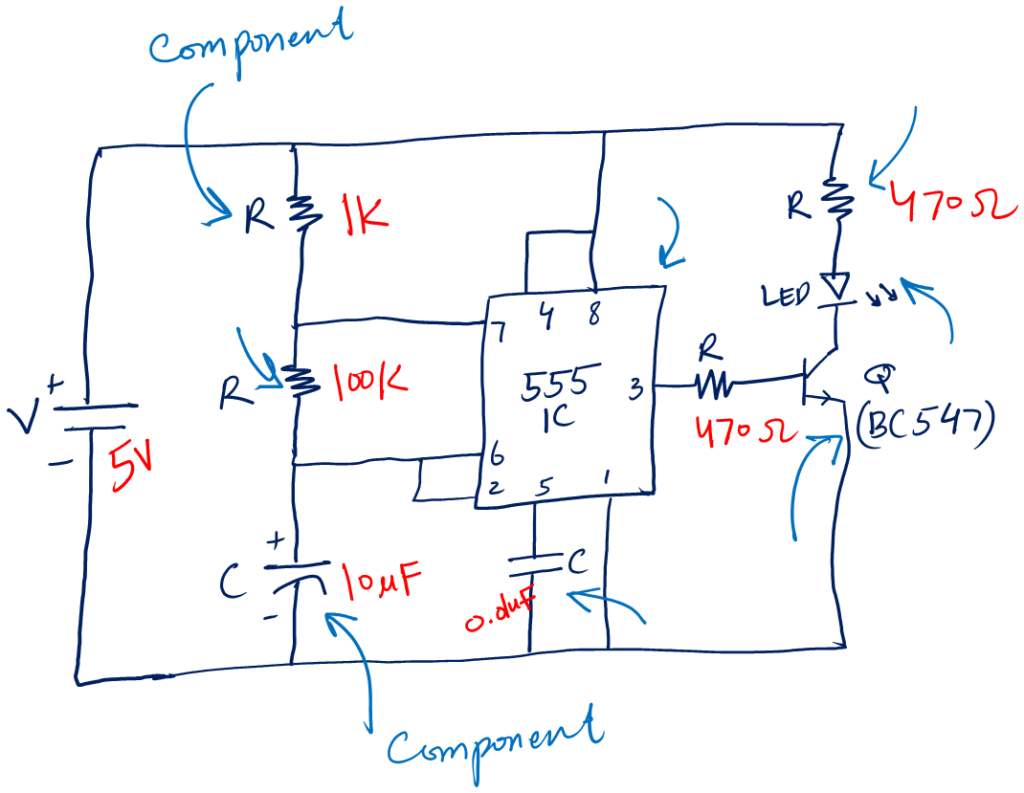
You see that this schematic is the combination of various electronic components represented by their symbols (which we will explore in the coming sections).
Circuit symbols are very important. Without symbols, explaining or drawing a circuit on paper or software would not be effective and easy.
Now let’s see various electronic component symbols and their circuit functions.
a. Electronic components
First, we will start with core electronics components and then we move towards the symbols and functions of the electrical component as well.
1. Diode
In simple words,
A diode is a two-terminal electronic component. It can control the flow of electricity. You can say that a diode is like a switch. But the only difference is diode can only allow the flow of electricity in one direction.
Let’s have a look at the circuit symbol of a diode.
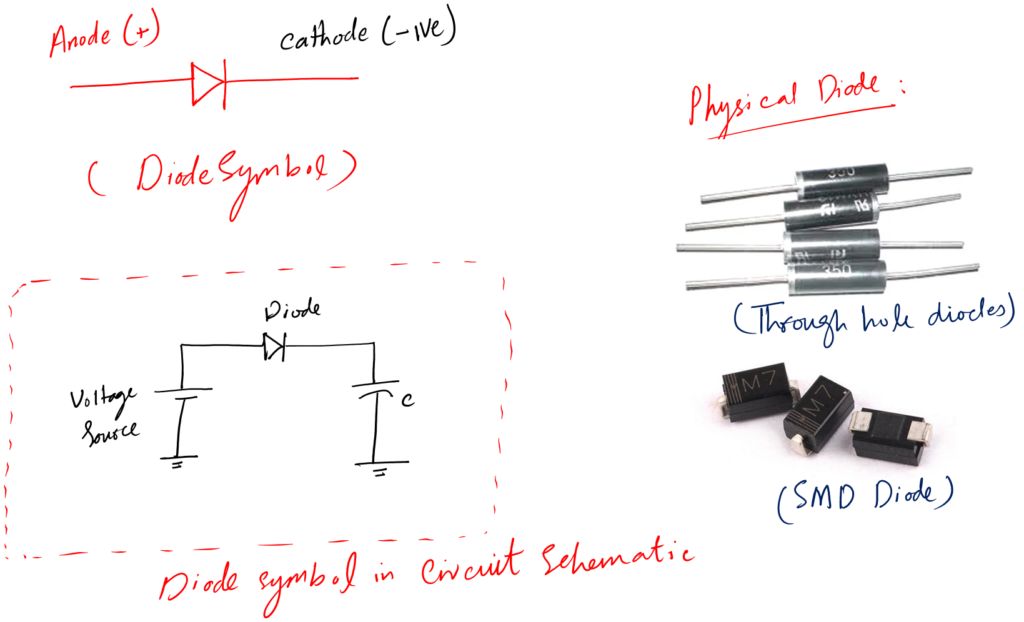
Basic circuit functions:
- Allow the flow of current in only one direction
- We use it for half-wave rectification
- Full wave rectification (for designing a power supply)
- We use it as a signal clipper and clamper
A side tip: To know the circuit symbol of the unknown diode you can use a component tester like M328 Tester (Amazon link). M328 will give the diode symbol and its correct pin configuration. It will also tell you if the diode is good or bad as well.
2. LEDs
In simple words,
LED stands for light-emitting diodes. These are the types of diodes that upon application of voltage glow and emit light.
Most LEDs have two terminals, and they come in various shapes and colors.
Following is the circuit symbol of an LED.
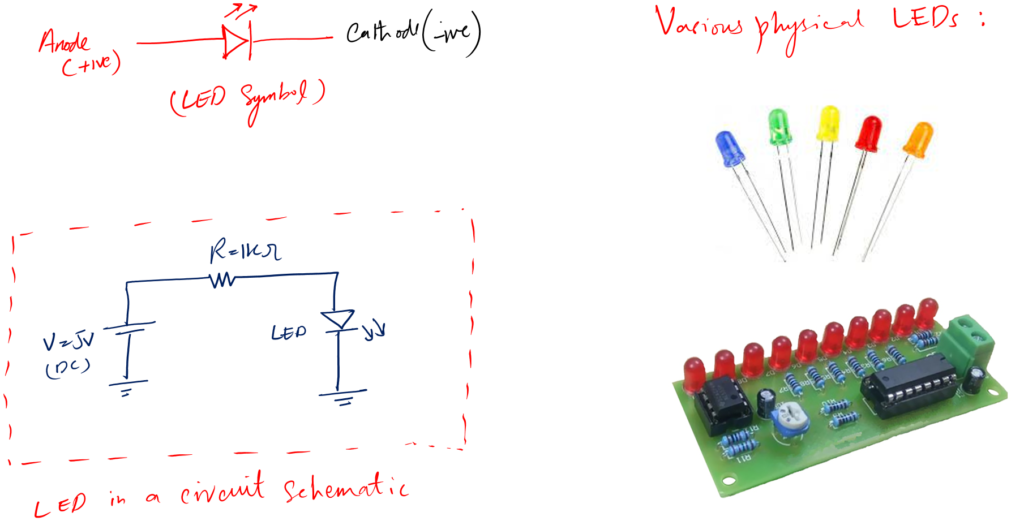
Circuit functions of LEDs
- The main function of an LED is an indication
- Troubleshooting
- Decoration purposes
3. Zener diode
Zener is another type of diode. It is useful when we want to filter out certain voltage levels, or if we want to have constant voltage levels all the time.
Following is the circuit symbol of a Zenor diode.
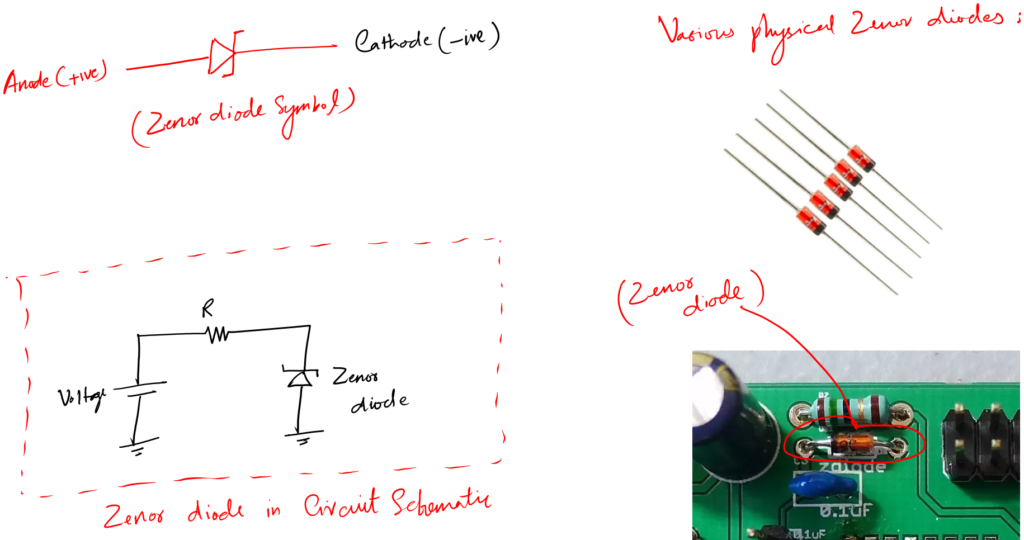
Remember that the only difference between the circuit symbols of a diode and a Zener diode is the tilted edges.
Circuit functions of Zenor diode:
- Voltage regulation and stability
- Stable power supply design
- Working in reverse biased condition
4. Schottky diode
When it comes to fast switching the normal diode fails to deliver.
That is why there felt a need for a fast-switching diode and the Schottky diode was invented.
Schottky diode like the above is a two-terminal electronic component. The following is a circuit symbol for this electronic component.
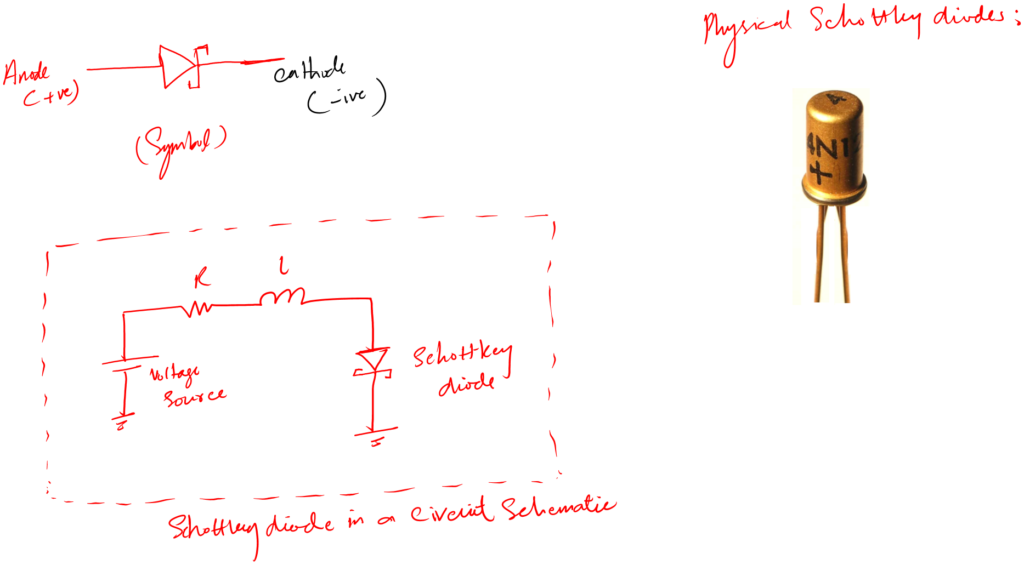
The symbol difference is, that the cathode side is more likely an S shape.
Basic circuit functions:
- The main function of this diode is the fast recovery time
- Faster switching
- Very low forward voltage drop
5. SCR
SCR stands for silicon-controlled rectifier. These are those diodes that have four layers and are used in almost every high-power equipment.
Following is the circuit symbol of SCR.
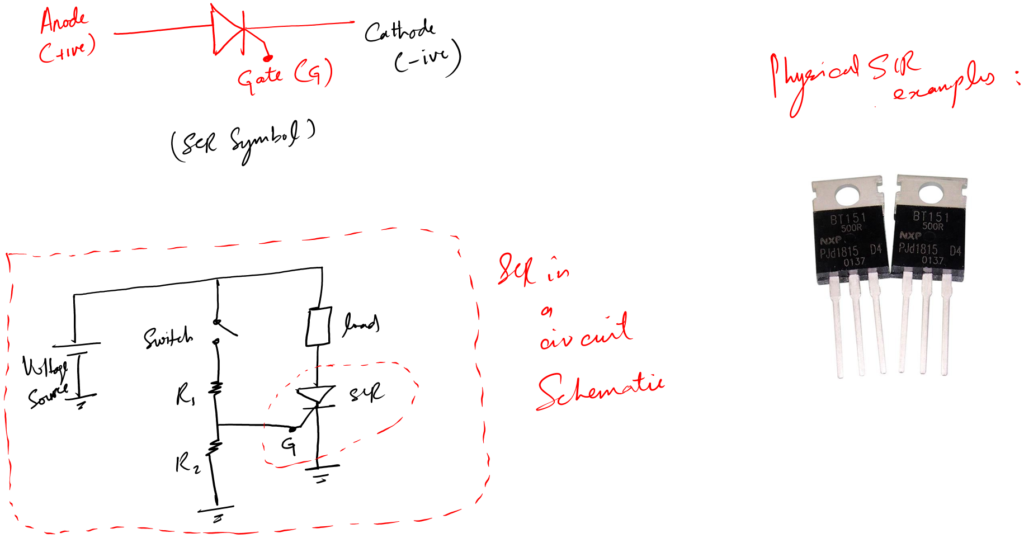
If you pay attention you will see that SCR has three terminals rather than two. The third terminal is called the controlling gate terminal.
Basic functions of an SCR
- To control the flow of current in a circuit.
- This means that the current at the gate terminal controls the current flow from the anode to the cathode.
Alright!
So far we looked at different diodes. Now, let’s move toward our next components.
6. Transistors (BJTs)
You know, I believe without the invention of the transistor there would be no such technological advancement in the world.
It is such an important component among all the others. In simple words,
A transistor is a three-terminal component that can control current, amplify a weak signal, and automatically switch the load or state of the circuit.
Following is the circuit symbol of the transistor.
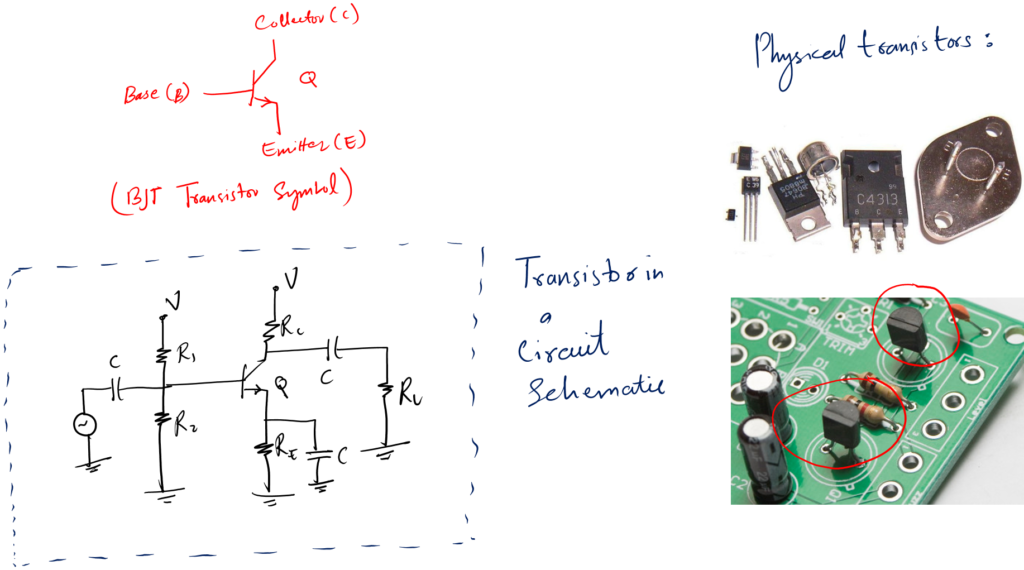
The main functions of a transistor in a circuit:
- Amplification
- Switching
- Control
- Safety
Transistors come in various types. The following are the most used ones:
- Bipolar junction transistors (BJT)
- MOSFETs
- IGBTs
- JFET
Let’s explore these types in the below sections.
As we are interested in electronics components symbols and functions.
So, I have already shared the functions of a transistor. These functions are the same for every type. But each type has a different circuit symbol.
7. NPN and PNP
BJTs come in two main subtypes, NPN and PNP.
NPN has P-type material sandwiched between N-type materials. While PNP has P-type material in the middle.
Following are the circuit symbols of these transistors.
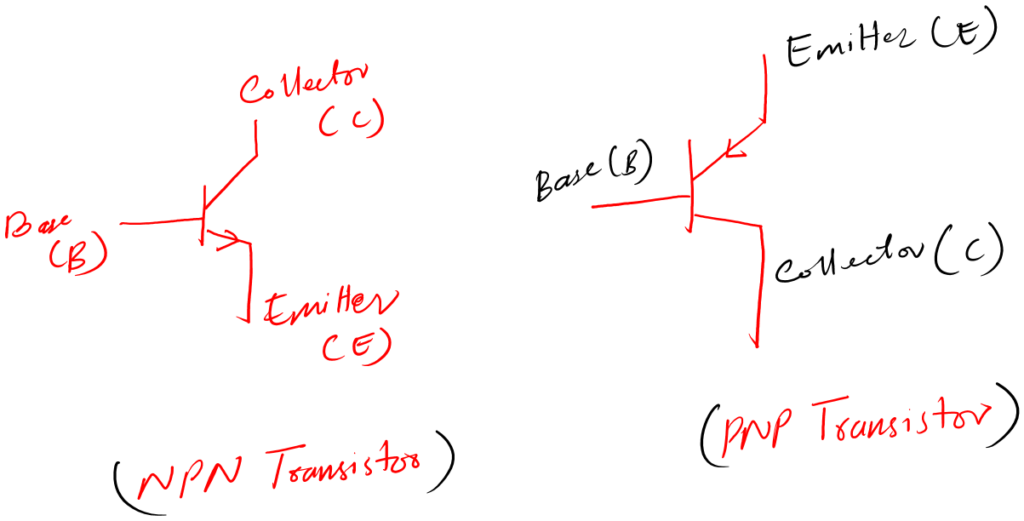
The difference in the symbol is the small arrow. In NPN it is below and in PNP it is above.
Both these types do the following functions:
- You can use them as a switch
- You can use it to amplify weak signals. It can be used as a gain provider in the circuit.
8. MOSFETS
MOSFETs stands for metal oxide silicon field-effect transistors. Its main function or you can say the difference is, that it has very high-speed switching capability.
It has three terminals drain, source, and gate. Following is the circuit symbol of a MOSFET.
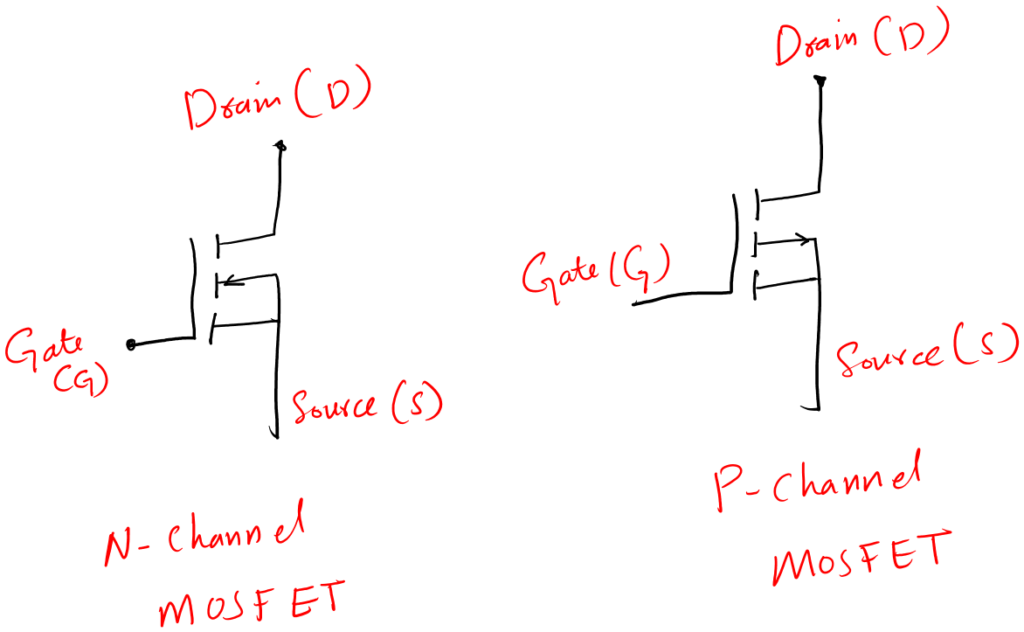
Main circuit functions:
- An important function of MOSFET is, that they provide high resistance at the input side.
- Because of this MOSFETs are used as resistors in very large-scale integrated circuits
9. JFET
JFET stands for junction field effect transistor. It is the sub-type of MOSFET.
It has three terminals and the following is the circuit symbol of JFETs.
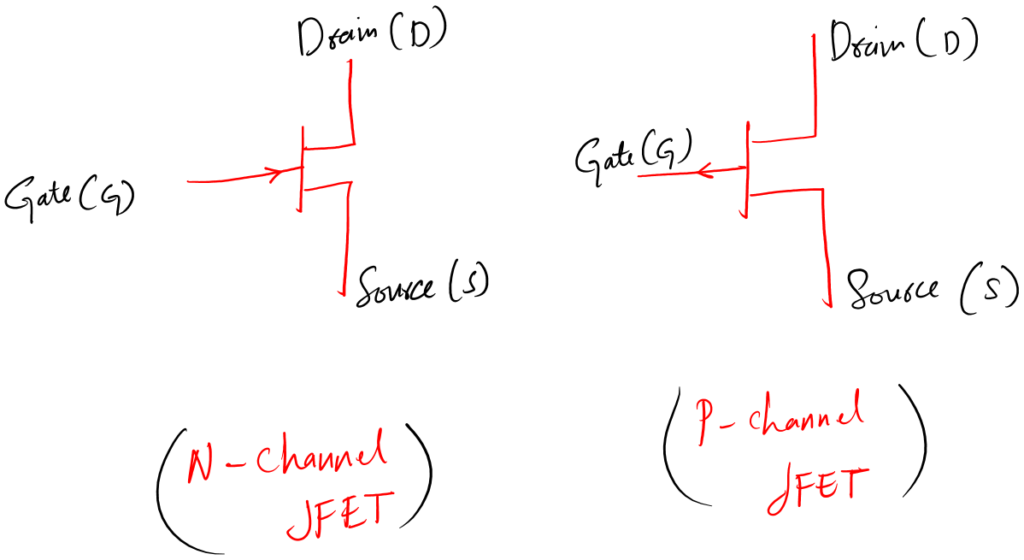
JFETs have two types. One is called the Positive (P) channel and the other is the negative (N) channel.
Circuit functions:
- The main function of this guy is fast-switching
- High input impedance.
10. IGBTs
IGBT stands for insulated gate bipolar transistor. This is mainly used as a switch.
Following is the circuit symbol of an IGBT.
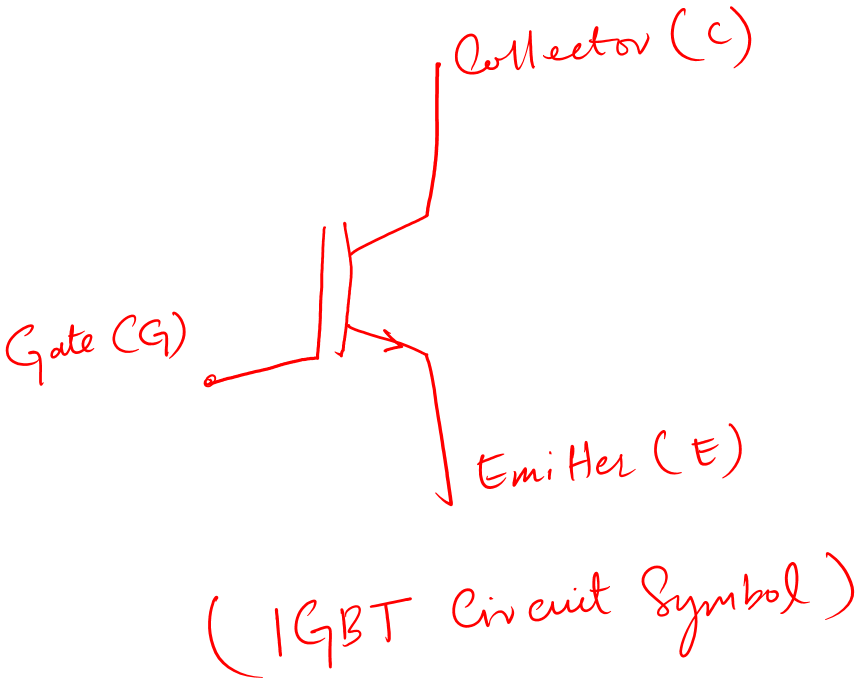
Main circuit function:
- IGBT is somewhat similar to bipolar transistors except they have insulated gate features.
- This insulated gate makes it highly efficient.
11. Integrated circuits (ICs)
Integrated circuits play a crucial role in today’s modern technology. In integrated circuits, small blocks of circuits are grouped in a small package to perform a certain task.
Most of the time, integrated circuits purely consist of millions of transistors.
Like in the signal IC chip of a mobile processor, there are tens of millions of transistors working together. This number is increasing due to the high demand for better speeds.
Following is the circuit symbol of an IC.
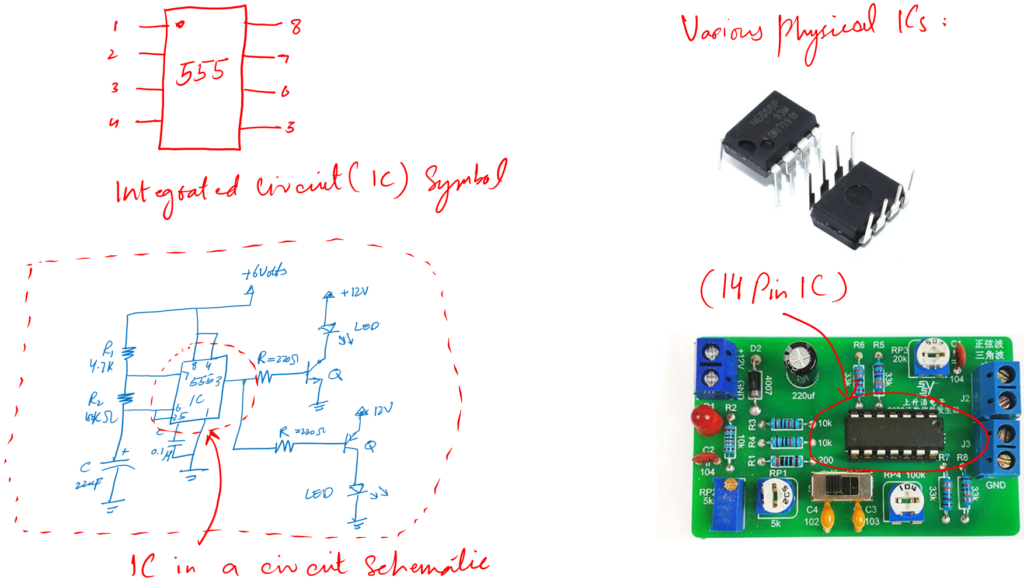
The legs you see in the pictures are called the terminals of IC. Now, the number of these terminals may vary depending on the IC function.
Main circuit functions:
- Programming
- Decision making
- Control
- Monitoring
- Signal processing and analysis
- Memory
- Processing
12. Regulators
In electronics, we don’t like changing voltage levels. They are considered unstable and can lead to false outputs sometimes.
To get contact voltage level we use regulator ICs at the output side of a power supply or any other case.
In short, regulators are used in circuits to regulate voltages or currents. Following is the circuit symbol of a regulator.
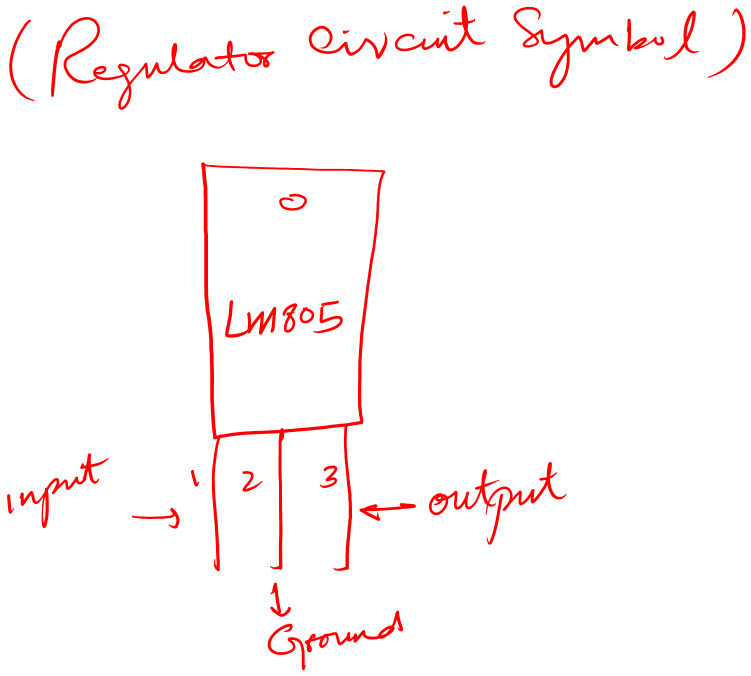
Main circuit function:
- It retains a constant voltage level no matter what load you connect to it.
b. Electrical components Symbols
So until now, we have been talking about electronic components symbols, and functions. Now let’s move toward electrical components.
1. Resistor
The first on the list is a resistor. I guess most of you may have heard of this component. It is very common and used almost in every electrical and electronic circuit.
Following is the circuit symbol of a fixed-value resistor.
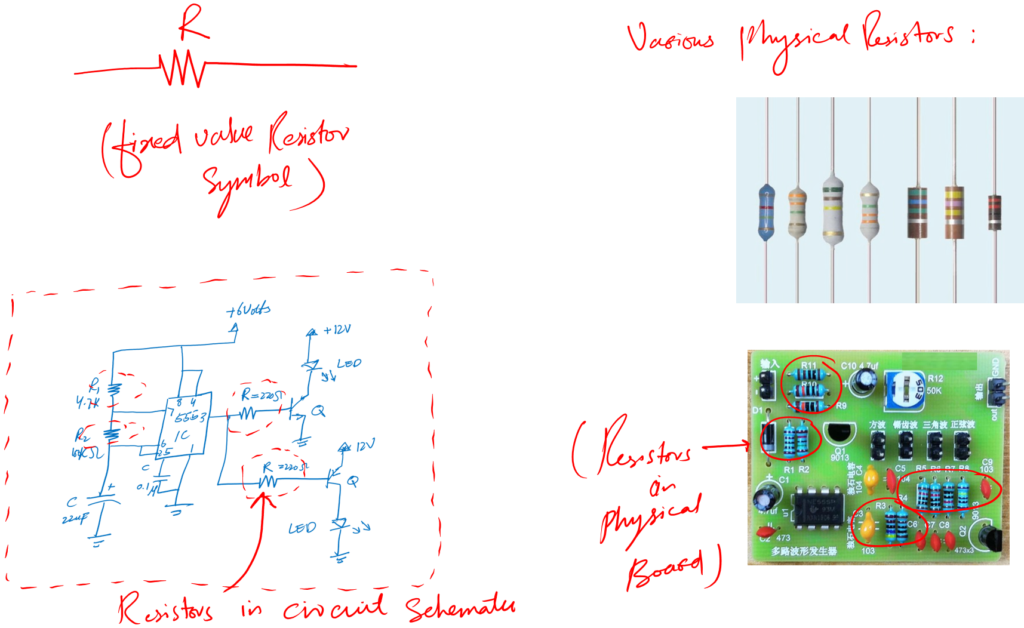
Main circuit functions:
- The main function of the resistor in a circuit is that it limits the current flow.
- We use resistors for voltage division in the circuit.
- We use it for safety purposes.
Here is the detail article about resistor basics that will walk you through resistor functions, types, and how to to use it properfly in circuit design.
2. Potentiometer
A potentiometer is known as a variable resistor. It is called a potentiometer because using it we can change the potential difference between two points.
Following is the circuit symbol of a potentiometer.
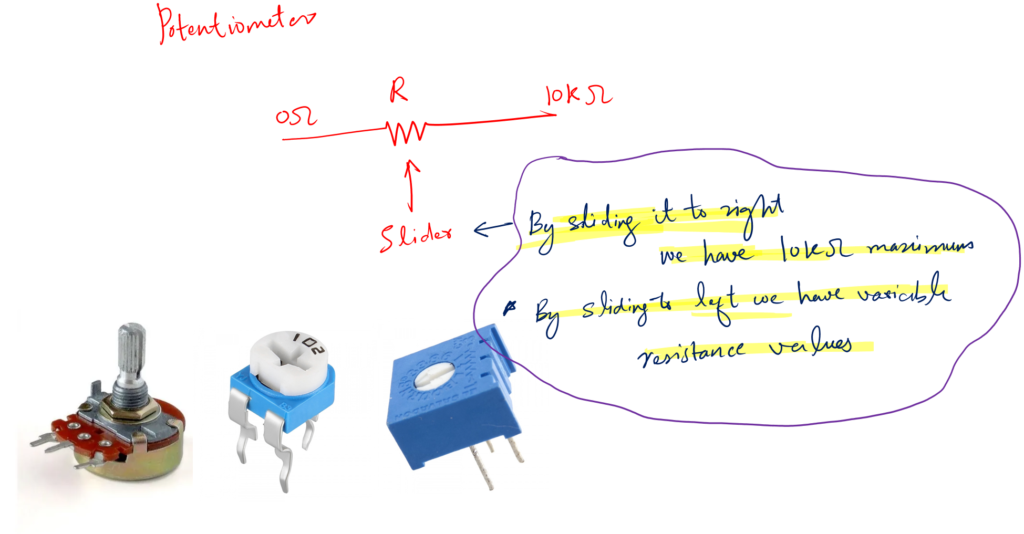
Main circuit function:
- This type of resistor can have various resistance values thus making it perfect for circuit tuning.
3. Capacitor
The second electrical component is a capacitor. It is a two-terminal component with a variety of useful circuit functions.
I believe you may have seen some big capacitors at the front end of every power supply. Or maybe you have seen some small tiny capacitors on PCB boards.
Following is the circuit symbol of a fixed-value capacitor.
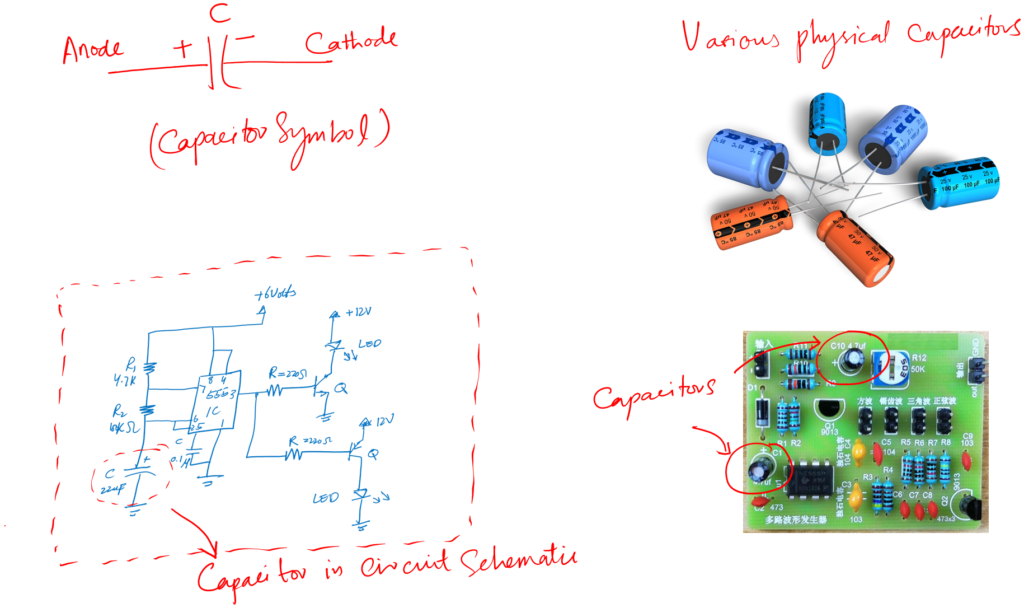
Main circuit functions of a capacitor:
- Capacitors are best for storing electrical energy.
- The capacitor acts as a voltage source in the circuit.
- Sometimes we need a source that can give us high current in a very short time like instantaneous. In such a situation, capacitors are very useful. The reason is capacitors easily charge and discharge and can give you a discharge rate in milliseconds.
- Capacitors function in circuits as Noise Filter
- Frequency harmonics blocker or eliminator
4. Electrolytic & Ceramic capacitor
The first type of capacitor is an electrolytic capacitor. It is polarity-dependent. This means you have to be very careful when connecting the terminal of this type of capacitor in a circuit.
Ceramic capacitors are the second type of capacitor which are independent of polarity. No matter how you connect it. It will perform its function.
Following are the circuit symbols of these capacitors.
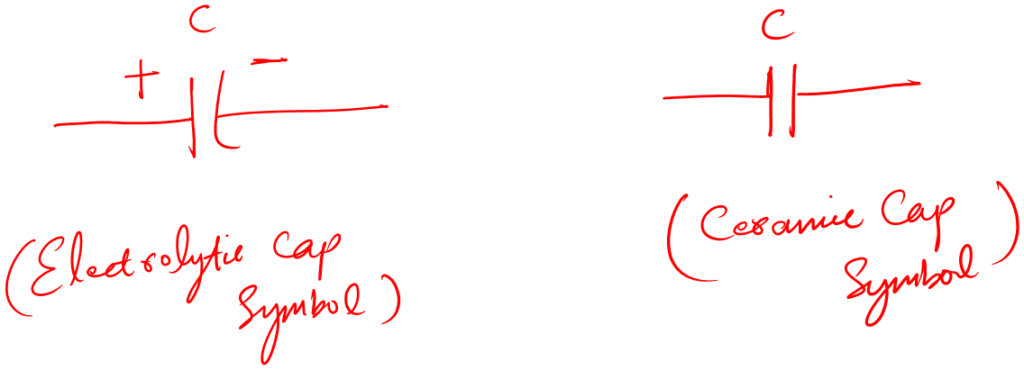
You can find electrolytic capacitors in the front end of any circuit. These are big, and their main function is to protect the circuit from incoming glitches and harmonics. Thus giving us stable systems and products.
5. Variable capacitor
As the name tells the whole story. It is that type of capacitor whose capacitance is variable.
That is we can change the capacitance according to our needs and situation.
Following is the circuit symbol of a variable capacitor.
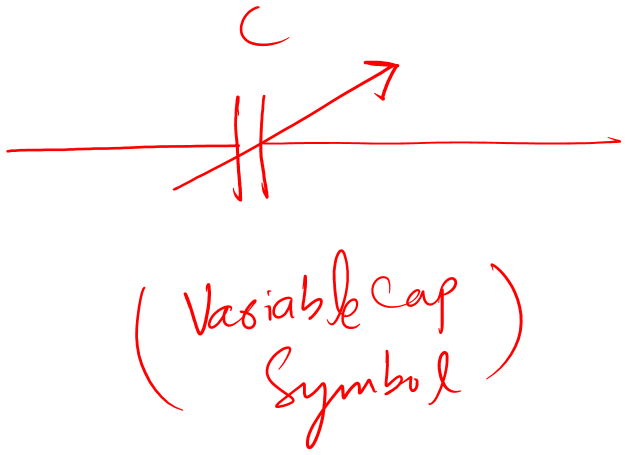
Main circuit functions:
- The main function of the variable capacitor is tuning.
- We use them in radio circuits a lot because as you know radio is all about tuning to various radio stations with different channel frequencies.
- We also use this type of capacitor for sensing
6. Inductor
The third electrical component is an inductor. It is a wire wrapped around making a spring-like shape.
This guy is not that popular when it comes to digital electronic circuits. The reason is we don’t want a bulky circuit board for commercial reasons.
Inductors are mostly useful in electrical circuits, but we avoid them in electronic circuits (except for power supplies) to the best of our abilities.
Following is the circuit symbol of an inductor.
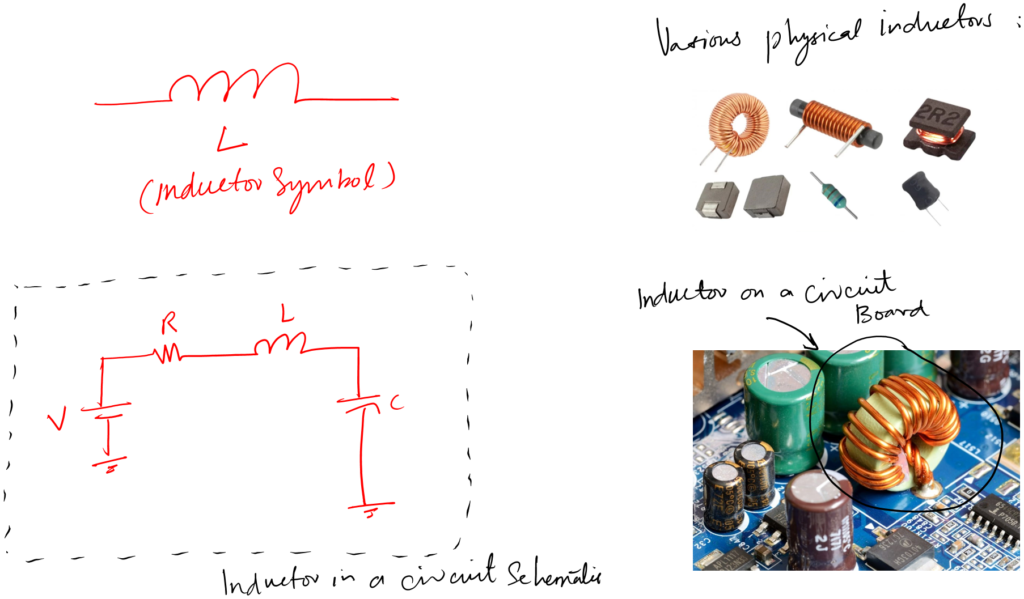
Main circuit functions:
- The main function of the inductor is filtering
- Storing energy
7. Variable inductor
The type of inductor in which inductance can be changed is called a variable inductor.
Following is the circuit diagram of a variable inductor.
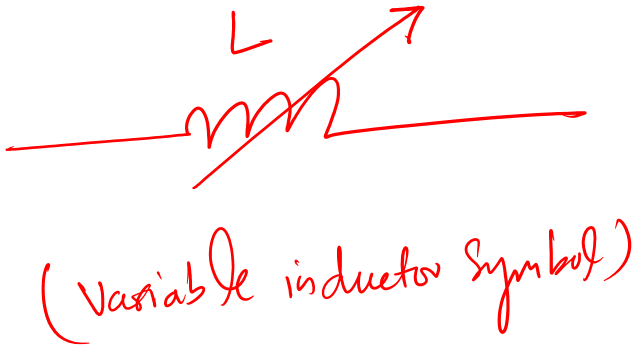
Circuit functions:
- The main function of the variable inductor is tuning.
- We use it in resonance circuits
- We use it in oscillator circuits
- Function and signal generators
8. Transformer
A transformer is a device that we use to transform or convert voltage levels from one to another keeping the frequency constant.
We use transformers in power supplies to lower the incoming AC voltage to our desired level.
Following is the circuit symbol of a transformer:
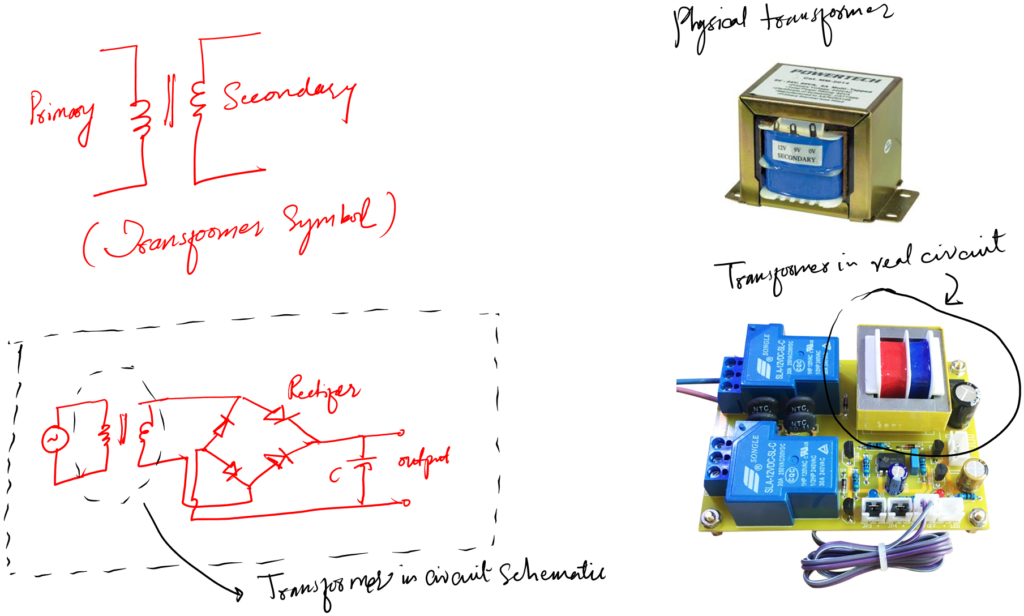
Main circuit functions:
- Its main job is to lower the incoming main AC (220V or 110V) to our desired level.
- Isolation
9. Relays
Relay plays a very important role in both electrical and electronic circuits.
Following is the relay symbol:
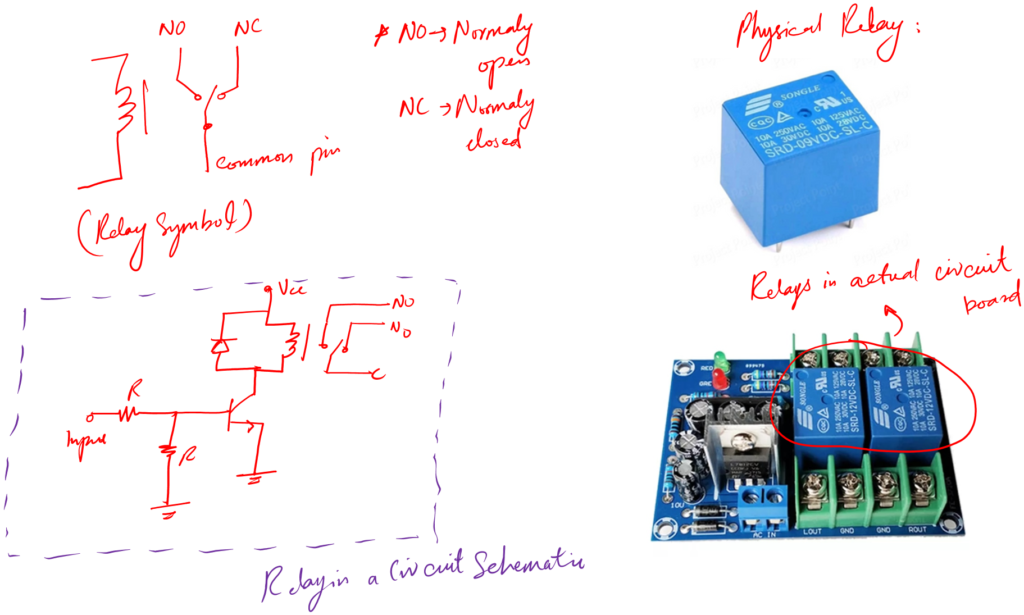
Main circuit functions:
- It is used to control high voltage, current, and power.
- When it comes to safety relays are the preferable choice for all circuit designers.
- We use relays to control high-voltage applications with just a low-voltage DC (usually in the range of 5V).
10. Switches
As the name tells the whole story. It is a device that we use to turn on and off our devices.
Switches are the simplest of all the devices we discussed above.
Following is the circuit symbol of a switch.
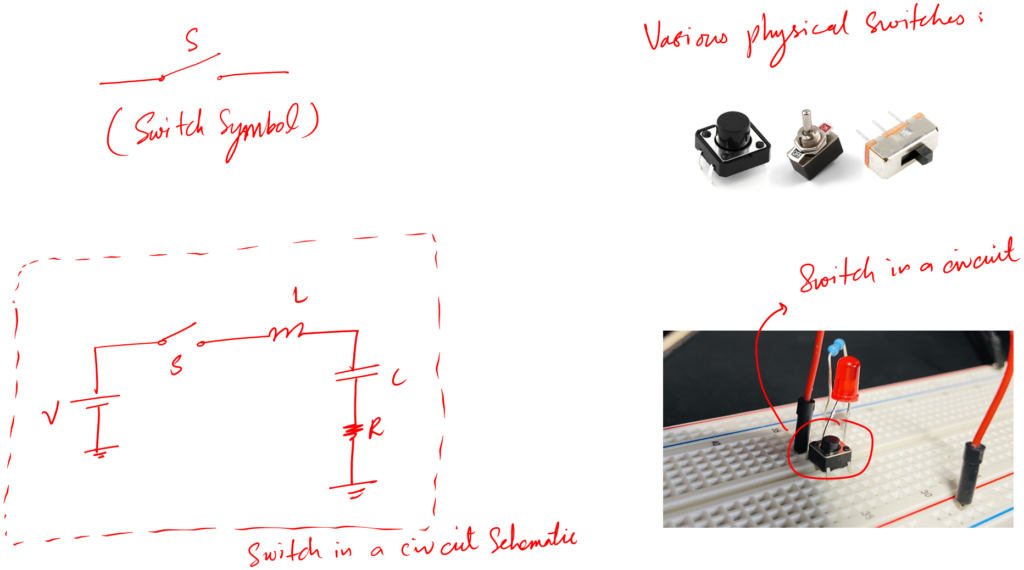
Main circuit functions:
- Turning on or off a load/circuit/device
- Testing
- Troubleshooting a situation
- Safety
Above are some basic electronic components, their symbols, and functions. I hope you enjoyed it.
Now, let’s cover some core concepts related to electronic circuits.
Types of components
Basically there are two types of components:
- Active components
- Passive components
Active components are those which need external power for its proper operation. While passive components don’t need any external power.
- Example of active components are: Transistors and integrated circuits.
- Example of passive componets are: Resistor, capacitors, and inductors.
SMD and through hole components
If you look closely at a circuit board, you can see that some components are mounted on the surface of the board while some component’s legs are soldered through holes.
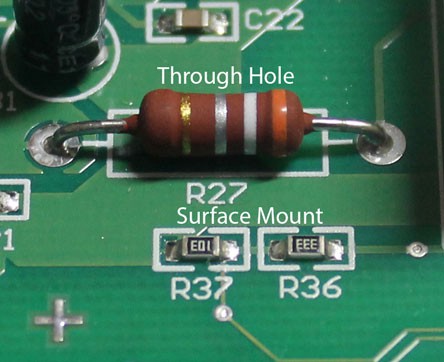
It is clear that components mounted on surface are the SMD components while the other is through-hole components. Each has its own benifits and usage in a circuit. It is not like one is better than the other.
One of the main difference betwenn SMD and Throug hole components is that: Due to the larger size of through-hole components, it provides better heat dissipation capability than SMD’s components.
Concept of component ratings
Imagine you are working on a project and you pick the components without checking their voltage and current operation limit, have you ever think what will happen?
Two things can happen if you apply high voltage the components can be damaged or burn out and if you apply low voltage the circuit will not work.
So for the safe and reliable operation of circuits understanding the operation limits which are also called component ratings is crucial.
In simple words,
Component ratings refers to the maximum operating limits or capacities that an electronic component can safely handle. It typically includes factors such as voltage, current, power, and temperature ratings.
As a beginner or expert, you have to refer to these ratings to ensure the components you use are compatible with the required circuit or system, enabling reliable and efficient electronic design.
Component organization
Different components are used whenever you want to build any project. It would be hard to find different components if these weren’t arranged and ordered properly.
The term “component organization” describes the systematic arrangement and management of electronic components in a way that facilitates effectiveness, accessibility, and appropriate storage.
The organization of electronic components is essential for several reasons, playing a crucial role in the efficiency, accuracy, and overall success of electronic projects.
Here are some key reasons:
- Time saving
- Frustration reduction
- Productivity
- Less human errors
- Preventing components from damage
You can arrange components in many ways. But the efficient way is to use some component organizing boxes and label them correctly.
Conclusion
In summary, to get started with electronics, you must learn about various electronic components. To make circuit diagrams on paper or in software. And to differentiate components from one another we use circuit symbols.
Without a unique circuit symbol concept working with electronic circuits and components would be messy and inefficient.
Understanding circuit symbols is important. But it is also significant to know the function of a component to be a good electronics engineer.
In this article, we just cover that. We look at some basic electronic components, symbols, and their main functions in circuits.
Following is a summary of the electronic components.
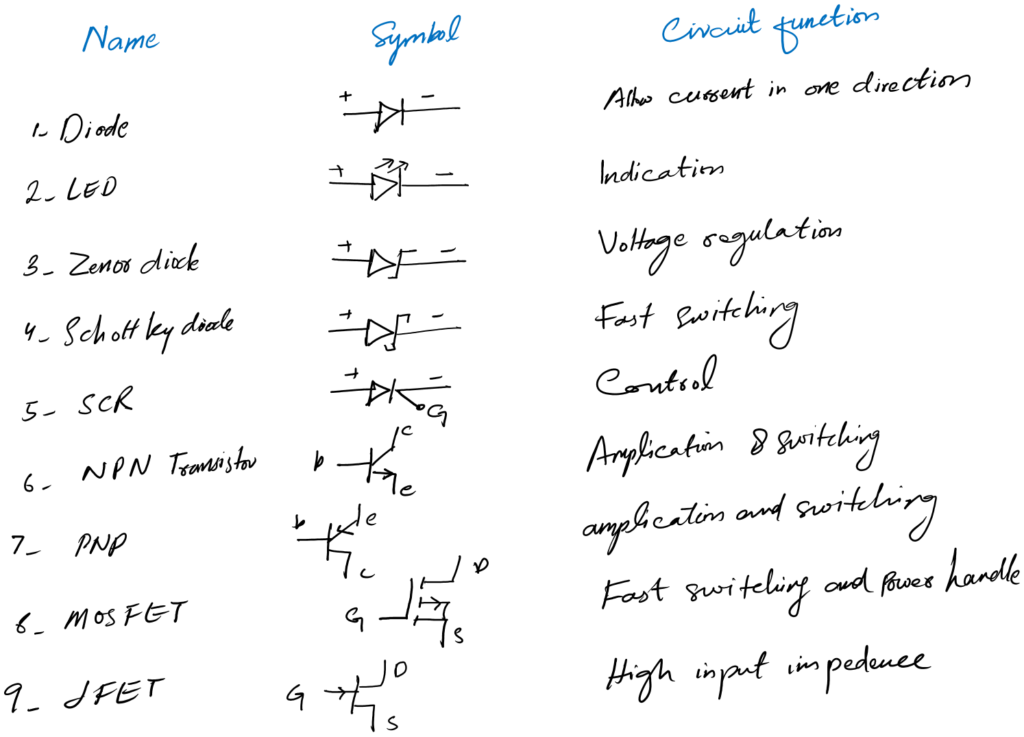
While following are circuit symbols of electrical components.
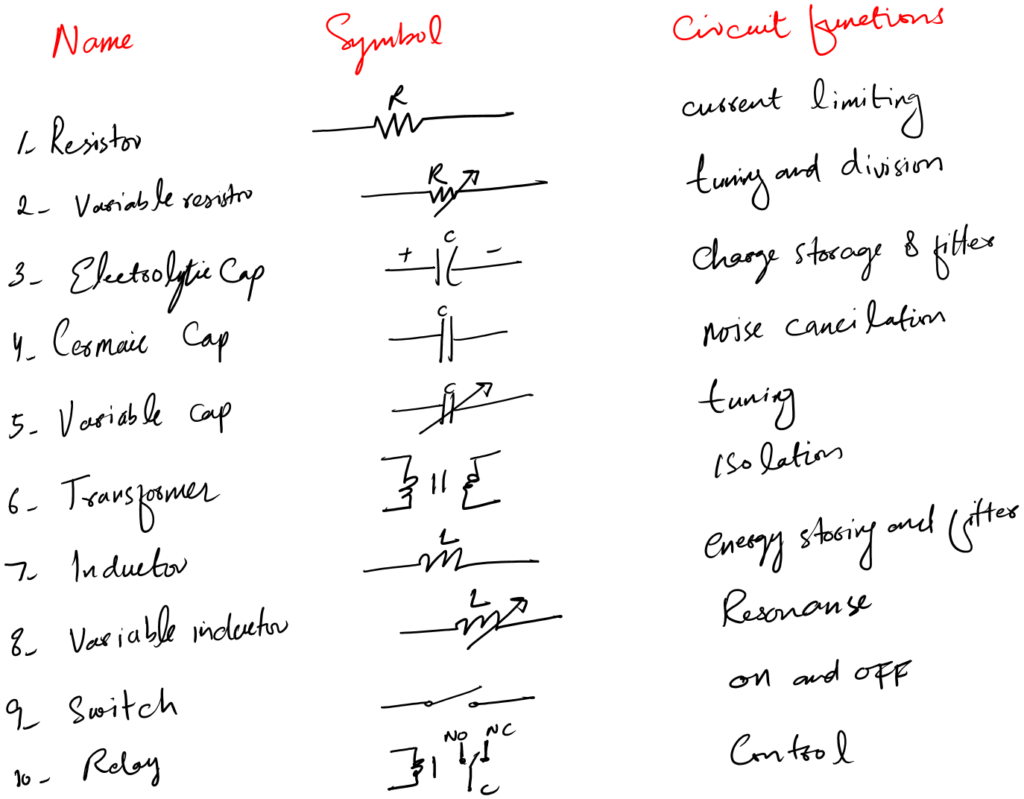
So, that is it. This is all I have for you about basic electronic component symbols and functions.
Thank you and have a grateful life.
**We learned about circuit components. But how would we know if the component we are using is good or bad? This question is so important because if you put a bad component in a circuit, the circuit will not work. To find the answer to this, here is a detailed guide on how to test and verify various electronic components.

well written
Thank you 🙂
thank you excellent information
Welcome 🙂
Thank you brother for sharing this knowledge to us . May Allah reward you abundantly and increase you In knowledge.
Welcome 🙂
Thank you so much and I wish you all the best in your whole life and family
Welcome 🙂
I have a picture board some of the picture I done recognize. Can you help me
I am just starting to learn more a bout electronic component.
Thank you so much.
Hi Abbas, thank you for your interest to teach some simple things but not easy to find all together
Just some note: please add triacs to your collection
Thank you and I will add that for sure 🙂